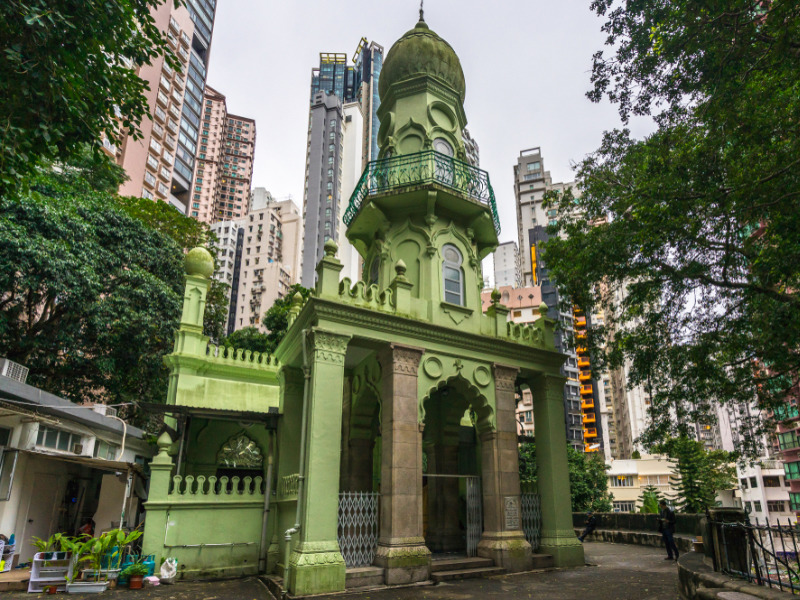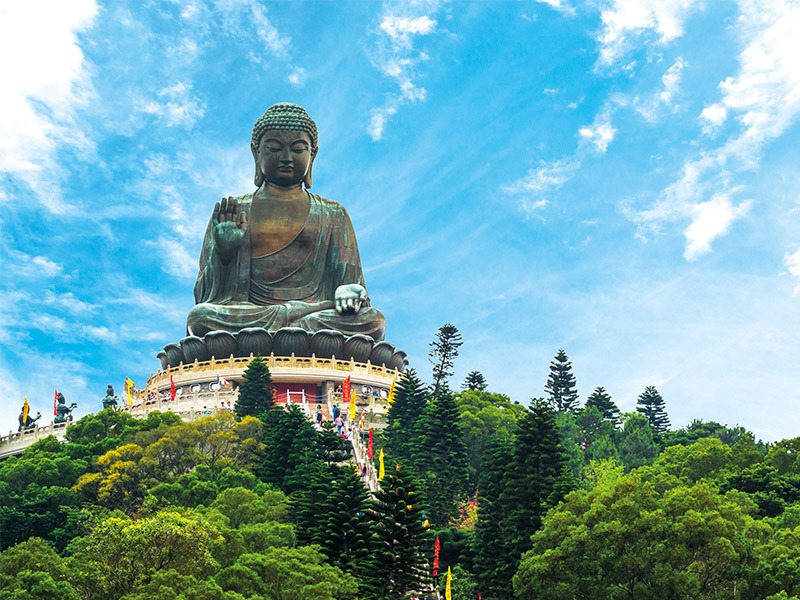Every district of Hong Kong has a church, temple or shrine of some kind, many of which are visually stunning and culturally significant, so well worth a visit. Here are some of the more noteworthy and historical temples in Hong Kong, along with other places of worship.
HONG KONG ISLAND
St. John’s Cathedral

St. John’s Cathedral isn’t just the oldest church in Hong Kong, it’s among the oldest Anglican churches in this part of Asia. Having held its first Sunday service in 1849, the Cathedral was converted to a Japanese clubhouse during the Second World War occupation; several of its original fittings were removed at that time – including, sadly, the original stained glass windows. After gradually being restored, the Cathedral remains a prominent city landmark, thanks to its distinct Gothic style. There are regular services held here.
4-8 Garden Road, Central
Man Mo Temple Sheung Wan
The largest Man Mo Temple in Hong Kong – “Man” is the God of Literature, and “Mo” the God of War – was built in 1847 and provides an interesting contrast to the busy CBD streets around it. Since1908, the temple has been managed by the Tung Wah Group of Hospitals; in 1993 it was designated a Grade I historic building and is now declared a national monument. Man Mo temples were traditionally patronised by students looking for a little divine assistance with their civil examinations during China’s Ming and Qing Dynasties.
Hollywood Road, Central

Jamia Mosque
The oldest centre of Islamic worship in Hong Kong, Jamia Mosque, previously known as Mohammedan Mosque, was built in 1890 to serve Muslim merchants, soldiers and men who worked as sailors (or “lascars”) on European ships. The building, located in Mid-Levels, was classified as a Grade I building in 2010, a title given to historic structures that deserve immense effort to help preserve. Architecturally, the mosque has a rectangular shape with a multifoil-arched entrance and Arabic-style windows.
30 Shelley Street, Mid-Levels

Ohel Leah Synagogue
Built at the start of the 20th century, and restored through a US$6 million project in 1998, Ohel Leah Synagogue sits at the core of Jewish social and religious life in Hong Kong. Located in Mid-Levels, and adjacent to the Jewish Recreation Club and Jewish Community Center, the cream-coloured two-story synagogue represents the Colonial Sephardic architectural style. It takes its name from the mother of three brothers from the Sassoon family of Indian merchants.
70 Robinson Road, Mid-Levels
Happy Valley Hindu Temple
There are thought to be as many as 100,000 Hindus living in Hong Kong, and this temple in Happy Valley is their main centre for religious and social activities. It’s a place for everything from medication and spiritual lectures to yoga classes. And, of course, celebrating the prominent Hindu festivals, including Diwali. It’s also popular for Hindu engagement and marriage ceremonies.
1B Wong Nai Chung Road, Happy Valley
Stanley Mosque
This one probably needs to be filed under “must see, but may not get the chance to …”. The reason? Stanley Mosque is located inside the operational Stanley Prison. It was Hong Kong’s fourth mosque, opening in 1937 to service Muslim employees working in the prison. The sandy structure – designated a Grade I historic building – has a large prayer hall, courtyard and wraparound veranda. While it’s not generally open to the public, the Correctional Services Department of HKSAR does grant some permits for its use on Fridays and special occasions.
53 Tung Tau Wan Road, Tung Tau Wan
KOWLOON
St Andrew’s Church
Located at Nathan Road in Kowloon, St. Andrew’s Church was lucky to survive its early years, with the city hit by one of its worst-ever typhoons in 1906, shortly after construction was completed. Around one in 20 Hong Kong residents were killed in the storm, and pine trees around the church were uprooted. The oldest English-speaking Protestant church in the city, St Andrew’s represents the Victorian Gothic architectural style, and is made of red brick and granite. The bells within the church’s tower are the original carillon of eight bronze tubular bells from Harrington’s of Coventry, England. There are multiple Sunday services here.
Nathan Road, Tsim Sha Tsui

NEW TERRITORIES
Ten Thousand Buddhas Monastery
First things first: are there 10,000 Buddha statues here? Nope. In fact, the current count stands at around 13,000! Built between 1951 to 1957, the Ten Thousand Buddhas Monastery is located on a hillside in Pai Tau Village and is accessible by stairwell consisting of 431 steep steps. (Bring a water bottle!) But the climb is worth it for the beauty of the monastery. Even the stairs are a feature, surrounded by statues of arhats, the Buddhist equivalent of priests. The upper floor of the main complex boasts four halls dedicated to Buddhist and Taoist deities, while a nine-storey pagoda rises from the monastery grounds.
220 Pai Tau Village, Sha Tin

Tin Hau Temple, Joss House Bay
Built in 1266 on the south end of the Clear Water Bay peninsula, the oldest and biggest of Hong Kong’s Tin Hau temples has had countless renovations over the centuries, most recently in 1840, 1877, 1962 and 2009. Sometimes referred to as Tai Miu (“Great Temple”), the building attracts around 50,000 people each year during the Tin Hau Festival (next celebrated on 15 April 2020). There are thought to be over 100 Tin Hau temples in Hong Kong, which are dedicated to the Chinese sea goddess Mazu. Two other well-known ones are the temple at Yau Ma Tei and the one next to the Tin Hau MTR station.
Clear Water Bay

Po Lin Monastery / Tian Tan Buddha
Aside from the fact that you can get to it via a fun cable car ride, the Po Lin Monastery, located on the Ngong Ping plateau of Lantau Island, is worth a visit for its religious significance. Founded in 1906 by three monks visiting from Jiangsu Province on the Chinese mainland, it was originally known as “The Big Hut”. The monastery houses three bronze statues of Buddha, representing his past, present, and future lives. Next door is Hong Kong’s “Big Buddha”, or Tian Tan Buddha, constructed in 1993 and a prominent tourist attraction today.
Ngong Ping, Lantau Island

The Big Buddha in numbers!
34: height in metres
60: cost in millions of HK dollars
108: times the Buddha’s carved bell rings each day
202: bronze pieces using in the construction
250: tons in weight
268: steps to reach the base
For more great info on life in Hong Kong, head here.





